Seasickness Sucks – 21 Tried and Tested Tips to Stop it.

Worried about seasickness? Let me help, so that boat trip you are planning does not ruin your adventure.
Every single passage made us all seasick. From the very start of our four-year-long liveaboard life.
As a mom, I hated seeing us all miserable. As a nurse, I spent hours researching how to help my “patients” feel better. I read peer-reviewed articles as well as forums and talked to every boater we met.
It took us a few passages, but we figured it out – here you go 🙂
All of our posts on: Boat Life @ No Texting & Tacking.
21 Ways to Sink Seasickness
Below are our best tips to avoid and manage seasickness. I have to start the list with our top favorite gadget, but all the other ones are still valid and very useful.
You will Like:
First Aid Kit Aboard, by a Boat Mom and RN. Supplies and Organization.
The Gadget that Saved us All
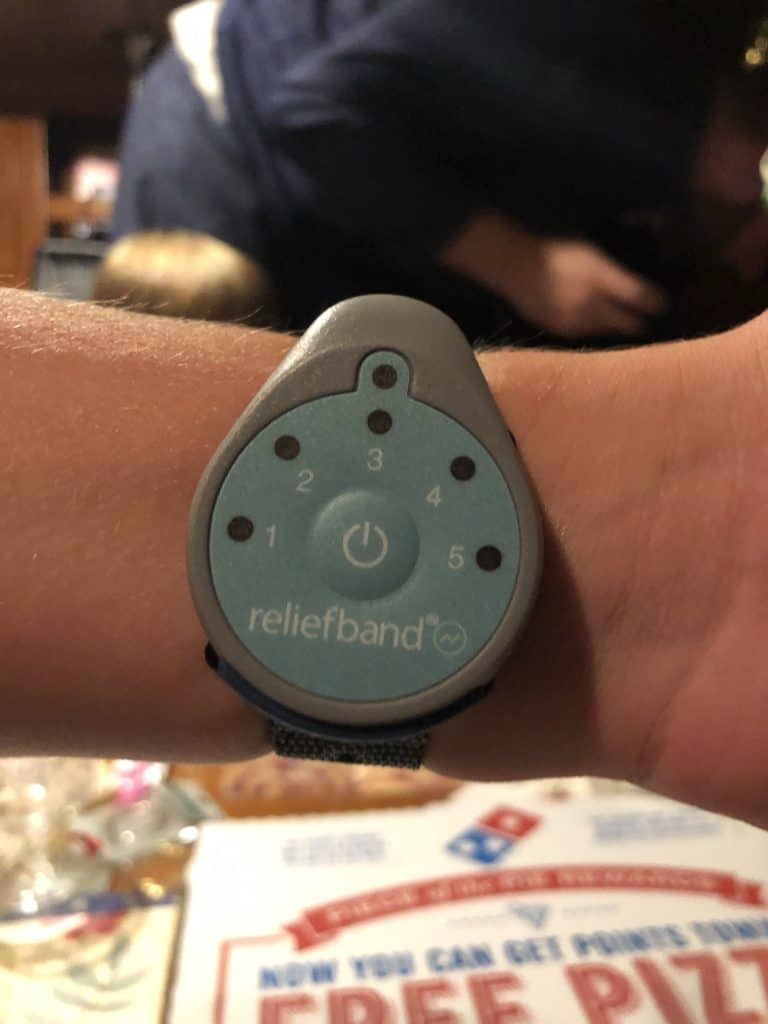
Reliefband is what saved us all from being miserable during passages. If you have no time to try all the tricks – get one of those bracelets and sail away.
We had five Reliefband bracelets aboard. Before we picked up anchor to go on a passage, we would put them on and keep them on for the entire passage.
My favorite part about these – they Do work and have no side effects.
They work by sending small pulses through the wrist, to the part of the brain that controls motion sickness (Reliefband.com).
Here is a brief video of how to properly use them.
We gave them to all of our boat-friends to try too. If I had a bit more of an entrepreneurial spirit, I would have become an affiliate long time ago. But, better late than never 🙂
Tip: Put the bracelet on about an hour before the trip/passage. Set it to the lowest possible setting that you can tolerate easily. Then adjust as you go.
Natural Ways to Prevent Seasickness
Preventing seasickness is the key for all of the tips and tricks to work best. So, from the start of the journey, try to do as many of these as possible, all at once.
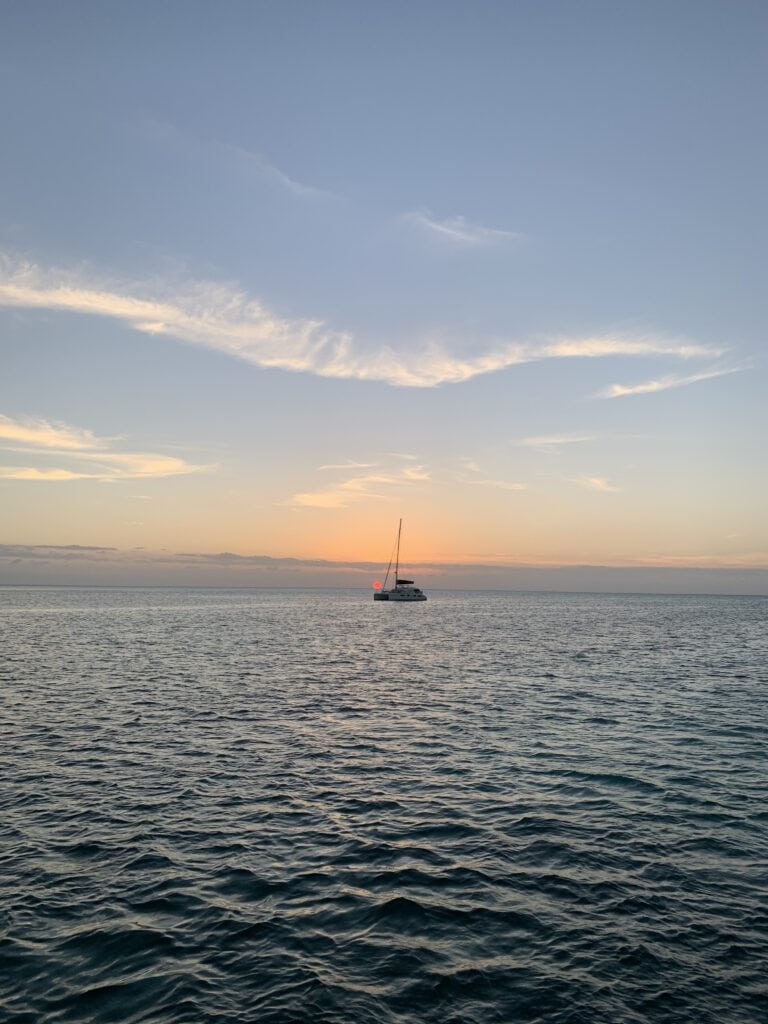
1. Look at the Horizon
The best way to begin a boating trip, is to be outside and look at the vast, beautiful sea around you.
The horizon is a great, large target to gaze upon.
When you are in motion, it is always a good idea to allow for a gradual adjusting to the motion. You feel that you are moving and your eyes need to see it too, but in a calming manner.
You will Like:
First Aid Kit Aboard, by a Boat Mom and RN. Supplies and Organization.
We had a pair of bird-watching binoculars aboard. They are of excellent quality, small and light. Perfect for a boat, or kids’ hands.
For more useful gadgets, check out my post, 13 Gadgets for Boaters.
Tip: Grab the binoculars and search the horizon from time to time – distraction and fresh air is a great combination against feeling seasick.
2. Stay outside
The fresh air and the breeze can help prevent seasickness.
Ocean passages and trips at sea offer amazing sights. True, there is a bit of too much water, water everywhere, but there is also sea life.
During our sailing adventures, we have seen many dolphins play around the boat, sea turtles, jellyfish, sharks, whales and birds trying to catch our fishing lures.
Tip: If the weather and the sea allow it, go out of the cockpit and sit somewhere towards the bow (front) of the boat. Just remember to put on your life jacket.
3. Be active.
Weather dependent, move around the boat, do small boat chores, to help you stay active. Here are a few simple ideas, which helped us:
- Grab onto the standing rigging and keep your balance as the boat is moving.
- Help adjust lines and sails.
- Learn how the sails respond to the wind.
- Check the fishing lines for seaweed (or fish).
Tip: Always keep one hand holding on to the boat, whenever you move outside of the cockpit.
4. Take the helm.
I never got seasick while steering the boat.
In fact, taking the helm was the only natural way to help alleviate seasickness that had already started.
You will Like:
First Aid Kit Aboard, by a Boat Mom and RN. Supplies and Organization.
Having an autopilot is great, but being at the helm, puts you in the driver’s seat and allows you to anticipate the movement of the boat a lot better.
This helps eliminate the element of surprised and unexpected motions, and it keeps you very active.
Tip: Hand-steering the boat is the best way to give those homeschooled kids credit for Sailing and Navigation (the best elective ever).
5. Take a Nap
Falling asleep during a sailing trip is a great way to help time go by and avoid seasickness.
During overnight and longer ocean passages, we all took shifts managing the boat. Since someone had to always be awake, the rest of the crew needed to conserve energy and sleep.
Sleeping on a monohull is a bit easier, than on a catamaran, because of the slamming of the waves under the cat clearance.
Here are a few more differences between cats and monos, if curious:
Catamaran vs Monohull: Let’s Solve This Thing!
Tip: You might get a bit more seasick as soon as you close your eyes, but once you are able to relax yourself, taking a nap will actually help.
6. Plug one ear
It is one of those things you might hear on the water. Some swear by it, others dismiss it as nonsense.
As with everything else, it is best to plug one ear before you start feeling seasick. The reason this works, is because plugging one ear sort of “confuses” the brain and allows your eyes to be the main source of information.
You will Like:
First Aid Kit Aboard, by a Boat Mom and RN. Supplies and Organization.
Sophie, who got seasick the most, tried this trick and was not a fan. But it is so simple and easy; try it, you have nothing to lose.
Any regular ear plugs will work. But call it, “The magic plug” and play that game with younger kids.
Tip: Plugging the ear opposite of your dominant side is something I have heard, but I am not convinced that makes a difference.
7. Cool off in the Water
Dumping some water on yourself is a great and quick way to stay refreshed and it helps with seasickness.
During a calmer passage, when the wind would die down, we would take down the sails, tie a life vest on a rope behind the boat and jump in the deep blue to cool off.
It worked like magic for us. Besides, it granted bragging rights to the kids, “Yeah, you know that continental slope? I swam over it.”
Tip: NEVER leave the boat unattended. One person must always remain aboard and keep an eye on those in the water.
8. Listen to an Audiobook.
Listen to an audio book, music, or podcast – it is a great way to distract yourself, by immersing yourself into something you enjoy and sending your brain away from seasickness thoughts.
Avoid books and screens.
Check out Amazon’s Audible membership, for special offers.
Tip: Listening to music, playing an instrument, and singing along also are great ways to take your mind off of how your stomach might be handling the trip.
Smart Snacks Against Seasickness
With any snack – small and frequent are the two magic words. Cruising on an empty stomach is a terrible idea, so here are some of our favorite “passage snacks” to combat seasickness.

You will Like:
First Aid Kit Aboard, by a Boat Mom and RN. Supplies and Organization.
09. Ginger
Ginger is the universal natural remedy for seasickness.
Ginger chews, ginger smell, ginger gum – any of these can do the trick.
We tried ginger many times. It helped a little, but the ginger chews we like are also very sweet, so it was not a reliable snack aboard.
We enjoyed the taste and the smell and that’s about where the benefits of ginger ended for us.
Tip: Try it, it won’t harm and if it helps – you can buy ginger in any country. Grate a little in your tea.
10. Stay Hydrated with Small Sips
Becoming dehydrated is very easy, while feeling seasick. You cannot bear the thought of drinking anything.
Dehydration is a very bad idea aboard, when you need your energy for the passage. It can lead to a series of problems, such as fatigue, headaches and drop in blood pressure – you do not need any of these aboard.
So, take small sips of some cold fluid. It can be water, tea or very watered-down juice. Avoid sugary drinks, they will make you more thirsty.
Tip: Keep taking small sips frequently. Do not drink a lot at once.
11. Small Bites
An empty stomach is a recipe for seasickness, and the acid can additionally irritate your stomach. Not fun at all.
Have small plain snacks and take small bites. Rather than eating an entire sandwich, have a few bites, then rest. Then have a few more.
You will Like:
First Aid Kit Aboard, by a Boat Mom and RN. Supplies and Organization.
Foods that are bland are best. As well as starchy foods. Below are some of our favorite passage meal-snacks:
- Tuna salad sandwitches.
- Egg salad sandwiches.
- Chicken salad sandwitches.
- Hummus wraps.
- Low-sugar muffins
Tip: Prepare all the snacks and sandwiches in advance, put them in small bags or boxes and keep in a cooler, near-by.
12. Fruits
Small bites of fruit are also a great snack to help with seasickness. Think small and frequent, just like with drinks and other foods.
Here are a few fruits and veggies, which worked well for us, during passages:
- Bananas – great food aboard.
- Grapes – refreshing, small.
- Orange slices – the smell helps too. Avoid on an empty stomach.
- Carrots – crunchy and refreshing. Try with hummus.
- Cucumbers – cut them up and keep cold in the fridge until ready to go.
Note: You may have heard the old superstition that bananas should never be on boats. We kind of ignore this.
13. Crackers and Pretzels
Saltines, crackers and pretzels are great help with seasickness.
Have some available to munch on – again frequently and in small amounts. I would sometimes take tiny bites off a single saltine cracker – yes, that small!
The goal is to not keep your stomach empty, but not get full either.
Here are our favorite seasickness snacks:
- Saltines – They are sold in every country we have visited. Cheap and plain.
- Pretzels – you can dip them in hummus, if feeling a bit more hungry.
- Lightly salted tortilla chips – try them plain.
- Potato chips – opt for the blander baked version.
Tip: Avoid dips, especially greasy, creamy ones.
14. Aromatherapy against Seasickness
Fresh and calming scents can help prevent and alleviate seasickness.
It is best to stick to smells, which evoke good memories and a sense of calm and freshness.
I used to be a childbirth assistant and since then, I always have lavender oil.
Here is what other boat-moms use:
“I’ve used grapefruit oil to great effect as an anti-nausea. I put a bit of oil on a cotton puff and breathe it in.” Behan, from Sailing Totem (they offer liveaboard coaching too!).
“I use mint mostly and sometimes lemon. Usually behind the ears under the jaw and across the diaphragm.” Kira from SV LaFronda
“Diffusing or drinking mint tea.” A helpful boater.
“Peppermint essential oil for seasickness. Under the nose, behind each ear and around the naval.” A helpful boater.
Here are a few essential oils to start:
Motion Sickness Bracelets
We have tried both of the bracelets I am recommending below and are completely biased for the Reliefband 🙂
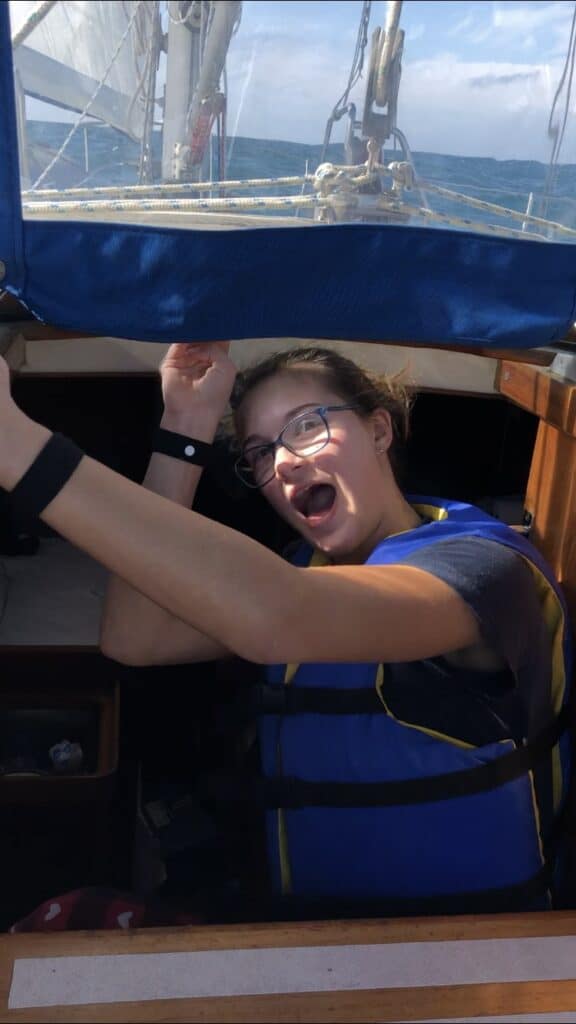
You will Like:
First Aid Kit Aboard, by a Boat Mom and RN. Supplies and Organization.
15. Reliefband bracelet
I had to devote a special place to the Reliefband at the start of the post, because after trying everything, we felt the bands worked the best for us.
Here is a brief video of how to properly use them.
Even though you should put them on before your start the cruising trip, we have tried putting them on after seasickness started, just to test things.
Yes, we have done the “dirty work” for you already, no need to repeat.
We have also tried taking them off, to see if it was all in our heads. They do work. Try taking them off, if you don’t believe me.
If you decide to purchase via any of the links below, I will earn a small commission at no additional cost to you. Thank you 🙂
Tip: We and our friends put them on kids all the time. Check with your healthcare provider about children (I have to write that. I’d be surprised if your pediatrician recommended against using them.)
16. Sea bands
We started with the classic sea bands. They worked with mixed success, occasionally.
They are elastic fabric bands, with a small plastic ball on each. When you put them on your wrist, the plastic ball applies pressure to a certain spot on your wrist.
They utilize the principles of acupressure.
Now, they do work against motion sickness, such as a car or a bus ride, but ocean passages are a bit too much.
When I worked as a nurse in a summer camp, we had quite a few children, who would not get on the field-trip bus without their sea bands.
Tip: If using for kids, give them a name, “The special bands” or something similar. You have to make them a bit more magical for enhanced effect.
Medications Against Seasickness
I am not a fan of meds. As a nurse, I know their place, time and benefits. I still prefer to try everything else, before resorting to medications.
Having said that, we have tried almost all of the meds below. They are part of our First Aid Kit Aboard.
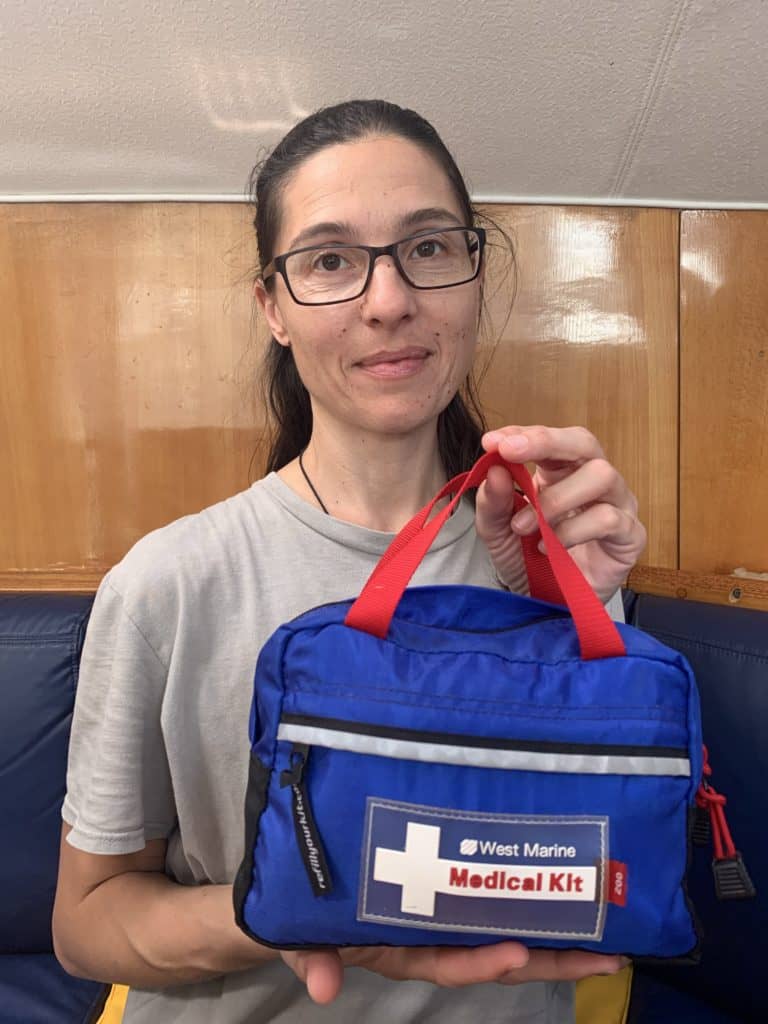
You will Like:
First Aid Kit Aboard, by a Boat Mom and RN. Supplies and Organization.
17. Dramamine and Benadryl
Dramamine is an antihistamine, with the generic name of Dimenhydrinate. It is quite effective against the symptoms of motion sickness.
It works well, but it will make you drowsy. It is not recommended for children younger than two years. We have tried it, not our favorite.
Benadryl is also an antihistamine, very similar to Dramamine. It’s generic name is Diphenhydramine Hydrochloride. It is another effective medication against seasickness. Much like Dramamine, it will make you very drowsy.
We keep both aboard, just in case of allergic reactions. They are also handy to give to seasick guests.
Tip: They work quickly but should be taken at least an hour before the trip begins. Once seasickness settles in, it is harder to manage.
18. Non-drowsy Meds
Non-drowsy antihistamines such as Bonine (meclizine) last for up to 24 hours, but are also not as potent as the drowsy couple above.
They will still make you drowsy, keep that in mind.
But, there is good news.
They work for up to 24 hours, so it can be a great option to take the edge off, or for someone not super prone to seasickness.
Tip: If you take the non-drowsy antihistamines the night before the passage, you won’t be drowsy the next day and not that seasick during the trip.
19. Vitamin C
You may have heard it before – Vitamin C helps with seasickness.
Vitamin C reduces the production of histamines, which are related to seasickness. There have been studies to back this theory, here is a link to one.
Guess what, we have tried that one too. With mixed success.
We would take a dose of Vitamin C (we each took 1000mg, youngest child at the time was 10 years old) an hour or so before the passage.
In addition, Sophie had her sea bands on, as well as an ear plug, occasionally. Most of those passages she ended up taking Dramamine too.
Tip: Vitamin C is also great to boost the immune system, even if not very effective with seasickness. We always had some aboard.
20. Patch
A scopolamine (Transderm Scop) patch is an effective anti-nausea medication and quite potent too. It is only available with prescription.
It should not be hard to obtain a prescription from your doctor, once you explain you would be on a boat (it is safe to use for most people, not approved for children).
I, personally, did not want to use it, because of the common side effects of dizziness and dry mouth.
Note: We met quite a few sailors, who loved using the patch, so it is a matter of personal preference.
21. Antiemetics
Once you feel seasick, it is a lot harder to reverse. Which is why any measure to alleviate seasickness should be taken before the trip.
You will Like:
First Aid Kit Aboard, by a Boat Mom and RN. Supplies and Organization.
We have sailed and thrown up quite a few times. It sucks.
Antiemetics help alleviate nausea once it has started. Antihistamines can also serve this purpose, which is why Dramamine and Benadryl can be effective once someone is feeling seasick.
Note: There are prescription antiemetics, such as Zofran (ondansetron), one of the more common ones. They can be very effective, but dizziness is a fairly common side effect.
What Makes Seasickness Worse
Instead of trying to handle seasickness, try to prevent it from starting, or being incapacitating, during a boat trip.
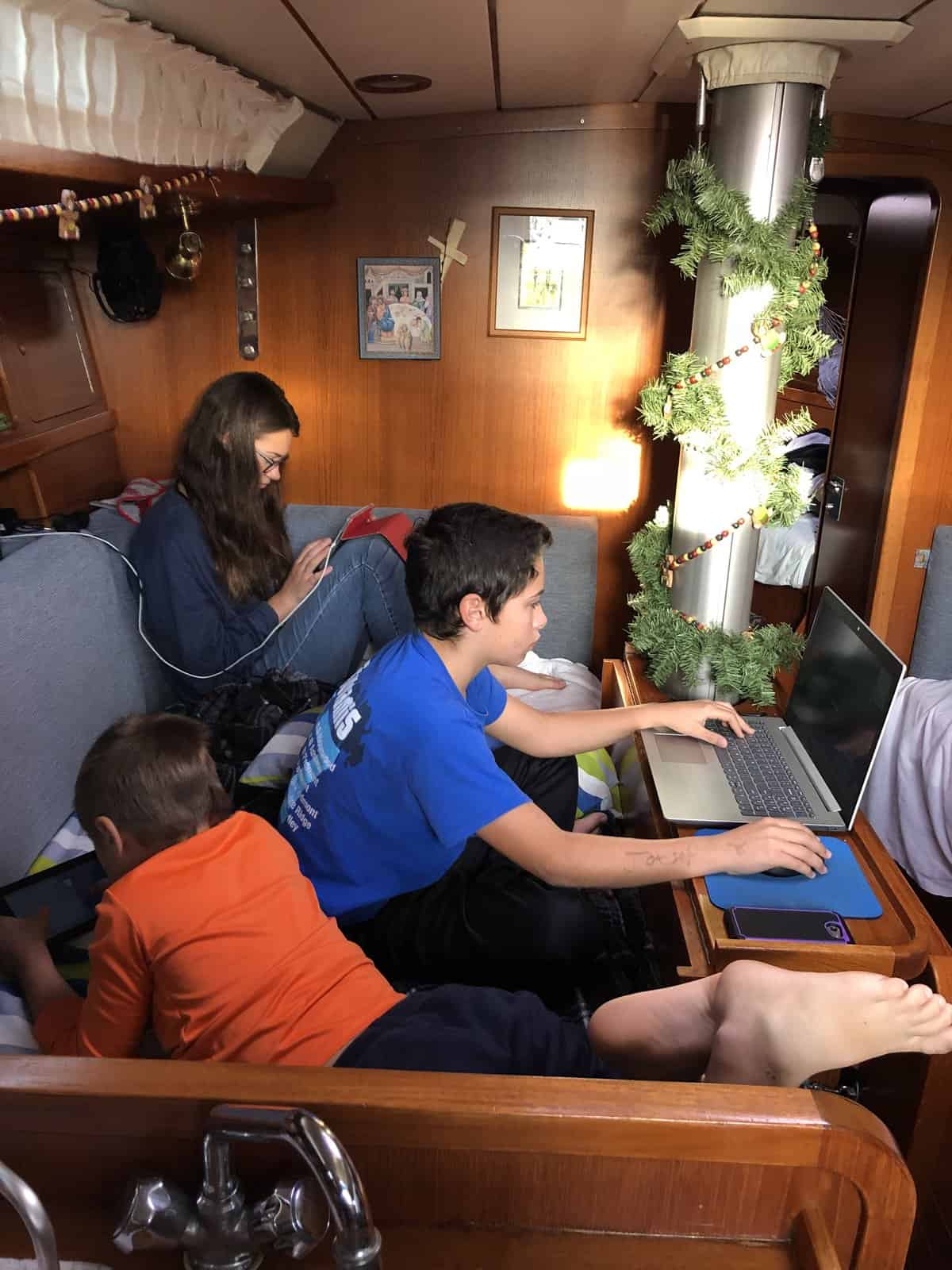
Here are a few things to keep in mind:
Full stomach
Do not start a boating trip on a full stomach. You will be seasick.
Do not start a boating trip on an empty stomach either.
Try snacking small amounts of starchy foods beforehand, as well as during the passage.
Tip: A pasta meal with whole-wheat pasta is a good source of sustained energy a few hours before the trip (or the night before, if sailing off in the morning).
Alcohol
Avoid using large amounts of alcohol before the journey. If you end up leaving with a hangover, you will be seasick.
Any drinking aboard is a bad idea during a passage. Especially if you are the one operating the boat.
You will Like:
First Aid Kit Aboard, by a Boat Mom and RN. Supplies and Organization.
Getting drunk aboard can cost you your life. Joe had to pull someone out of the freezing water, when he tripped and fell in, at a neighbor’s boat. It was by God’s Grace that we were nearby and heard him grunt.
If you are a guest and want to sip on some wine, as the crew is navigating and managing the vessel, don’t. Wait until you have arrived and the boat is still.
Note: Sorry, this is an anti-seasickness post.
Greasy foods
Greasy and fried foods before, during and after a sailing trip are a bad idea.
They are difficult to digest, totally not worth it.
Deep frying is not a good idea aboard anyway, the entire boat will smell like oil, so fried foods are less of a concern.
Stick to lean meats, pasta and fish.
Tip: Even the favorite potato chips are a poor choice for a passage (they are a poor nutritional choice anyway, but that’s a different post). Choose baked chips instead.
Screens and Books
Any screen and book can make you seasick during a passage.
With kids, the distraction might work well for a little bit, until you hear, “Mommy, my stomach hurts.”
If you are on a longer passage (longer that three days), once your body has adjusted to the motion and the motion sickness is gone, you can resume your usual routine.
While sailing our first boat, the kids were still young and did not take any night shifts with us. So, I would let them all watch a movie and go to bed. The ones more prone to seasickness were also given some medication.
Note: I did edit videos and wrote my blog during passages, but that was once I started using the Reliefband bracelet, at a pretty high setting.
What causes Seasickness?
Seasickness happens when our brain becomes “confused” by the signals it receives from your inner ear and your eyes.
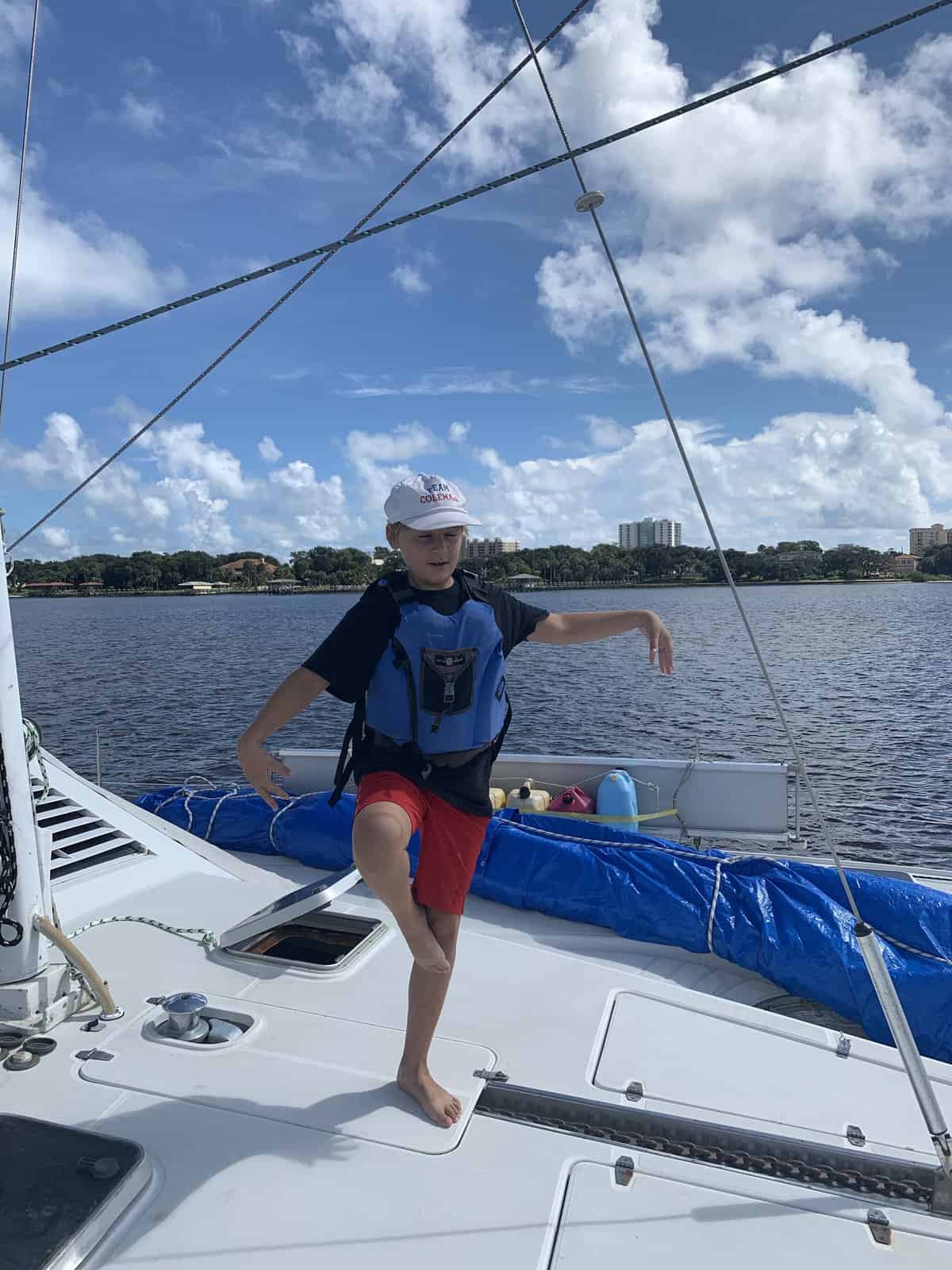
The inner ear is responsible for our sense of balance. When the middle ear “tells” the brain something is off with our balance and our eyes are trying make sense of it on their own, there is a miscommunication.
You will Like:
First Aid Kit Aboard, by a Boat Mom and RN. Supplies and Organization.
Miscommunication is never a good thing, especially aboard.
It is also why drivers are not motion sick, while everyone around them might be. Their ear senses the motion, the eyes see the same motion and the brain anticipates it.
Here is a bit better explanation of seasickness, if you are curious.
Kids and Seasickness
Our kids were pretty seasick during our very first passage, in the Chesapeake. Not a great start of liveaboard life.
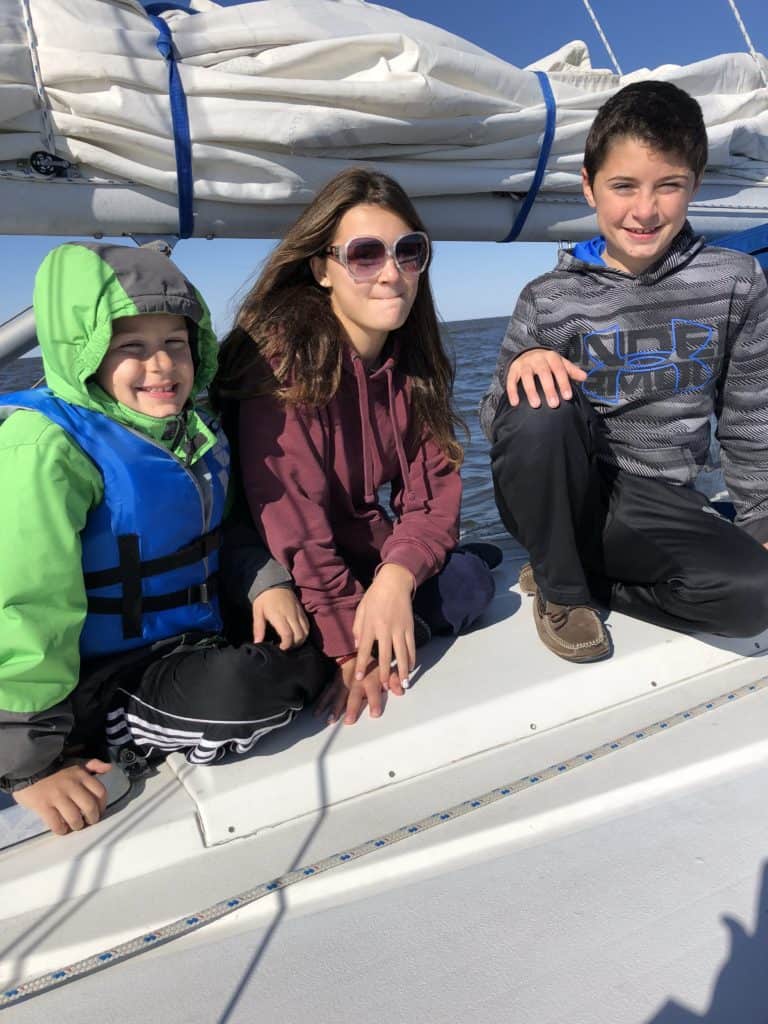
Some young children respond to seasickness by naturally falling asleep. It is their body’s way of coping with it. We had one such kid aboard.
Unfortunately, children outgrow this coping technique fairly quickly, so by the time he turned 10, he joined our miserable party.
You will Like:
First Aid Kit Aboard, by a Boat Mom and RN. Supplies and Organization.
Dealing with seasick kids aboard is never fun. It is even more challenging when you, yourself, are feeling like throwing up.
Grabbing a cracker, or a pill from the cabin below becomes the worst chore ever.
Here are a few tips when handling seasick children:
- Encourage them to be outside.
- Use the element of surprise, “Wow, look, dolphin!”
- Use distraction – listen to an audio book together.
- Avoid screens and books.
- Ask them to help with lines and sails, age appropriately.
- Try to sail with other boats and chat over the VHF.
- If using a bracelet, put it one before the trip begins.
- Give antihistamines at least an hour before the trip starts.
- All of the natural tips from this post work well.
Frequently Asked Questions About Seasickness
1. How long does seasickness last on a boat?
Around three days.
This is what is needed, for most people, to allow for perfect synchronization between our eyes, brain and inner ear.
So, for a longer passage, you may not need any pills or bracelets on your third day of cruising.
If you prefer shorter stretches of sailing, expect to be seasick every time.
2. How long does it last once you stop moving?
It might linger for a few hours, even once you drop anchor, or tie to the docks.
For some people (including our daughter), seasickness would become a bit worse after we had anchored.
The good news is that it does get better, usually within a few hours.
3. When should I take Dramamine?
At least an hour before your cruising trip begins.
Do not delay taking motion sickness pills. It is easier to prevent it than to try and manage it, once you start feeling sick.
Not to mention, if you are feeling like throwing up, the last thing you will want to do, is walk inside to look for pills.
4. Does chewing gum help seasickness?
For a very short time. While the flavor lasts.
Mint can help, as well as ginger. So, choose one of these flavors.
Chewing gum might take the edge off initially, but it really does not help. We have tried it, a few times. With the same unsuccessful results.
5. What is the best medicine for seasickness?
Dramamine and a medicated patch.
If you want to just grab a pill and not worry about testing the waters, Dramamine is your best over-the-counter bet. It will make you super drowsy.
A scopolamine patch also works very well, but it is only available with prescription. It comes with its own side effects.
6. What smells helps with motion sickness?
Mint, lavender and ginger are the most helpful scents.
You can use essential oils, to mix with a neutral oil and apply on the skin (wrist, neck, behind ears are common places). Or just grab a small cotton ball infused with the scent and smell it often.
We used certain scents, mostly natural ones, like orange peels, or cut-up ginger, to smell, but it was not enough for us.
7. How do sailors not get seasick?
They do.
Another boater once told me that if a sailor claimed he never got seasick, he had either not sailed before, or he was lying.
Naturally, it was guys who tended to brag about lack of seasickness. We, boating moms, had no problem sharing our misery and strategies to battle it.
8. How common is boat sickness?
Very common. Everyone will get some degree of seasickness, on some passages.
With enough cruises, you are bound to get seasick. There is no rhyme and reason to it.
Even if an exciting day-sailing rushes enough adrenaline to avoid seasickness, the next passage might not be so forgiving.
9. Will the kids hate the boat, if they are seasick?
They will, while feeling seasick.
It is inevitable. Noone enjoys that feeling. A miserable cruising trip can really spoil the adventure.
Use some of the tips I have in this post and you will find the winning combination for your children.
10. Why do I still feel like I’m on a boat after a cruise?
Your brain and your body need to both agree that you are not moving any longer.
Just like it can take a while for your brain, your eyes and your inner ear to synchronize their work aboard, it will take a little bit to shake off your sea legs, once you step on solid ground.
Some people suffer from mal de debarquement syndrome. In such cases, feeling dizzy and seasick on land, after a ride, can last for hours, days, or longer.
For the majority of cruisers, however, a couple of hours, or so are usually enough to get back to normal.
Let’s Wrap it up
Between every tip and suggestion in this post, you should be able to find the winning combination for yourself and the crew.
Seasickness is not fun at all, but it passes.
Be patient, pick your weather carefully (if you are the crew) and focus on the amazing memories and stories you are creating.
Do you have a favorite tip for seasickness – send me a note!
More Helpful Posts About Boating Life
Worried About Sharks? 10 Tips for a Safe Swim (by Boaters).
Pros and Cons of Living on a Boat. By Experienced Boaters.
Why We Never Missed Space, While Living on a Sailboat
Long-Term Traveling with Teens. Kill me Now.
References:
- PubMed – Impact of oral vitamin C on histamine levels and seasickness – PubMed (nih.gov)
- Mayo Clinic – Scopolamine (Transdermal Route) Side Effects
- Healthline – Antiemetic Drugs List: OTC, Side Effects, for Pregnancy, and More
- WebMD – Motion Sickness: Symptoms, Causes, Treatment, Prevention
- Reliefband – Reliefband®
